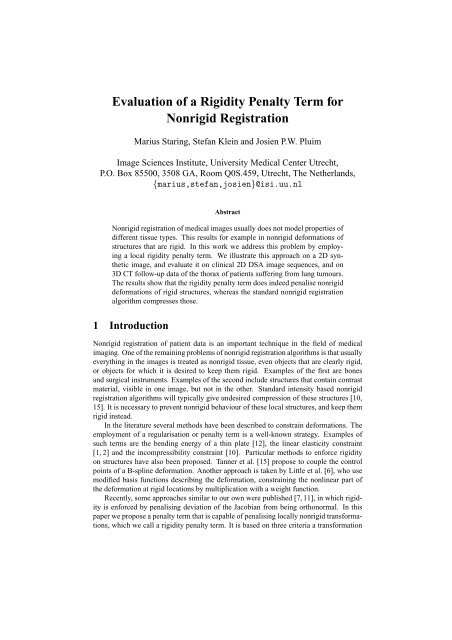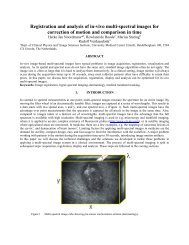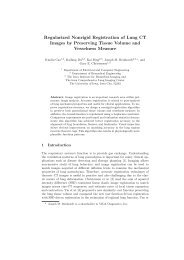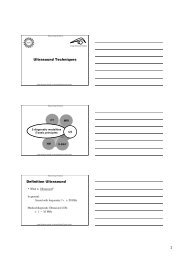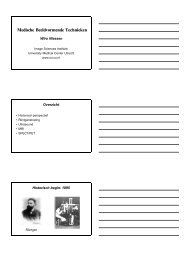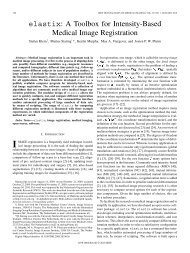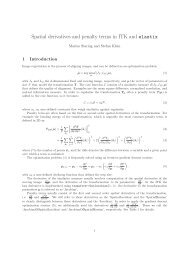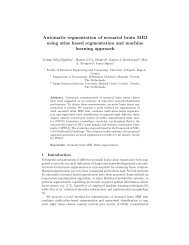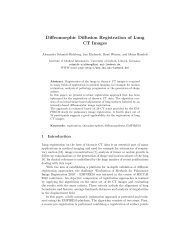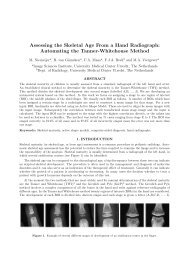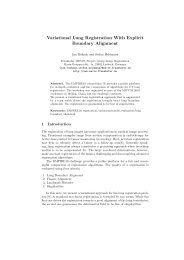Evaluation of a Rigidity Penalty Term for Nonrigid Registration - elastix
Evaluation of a Rigidity Penalty Term for Nonrigid Registration - elastix
Evaluation of a Rigidity Penalty Term for Nonrigid Registration - elastix
Create successful ePaper yourself
Turn your PDF publications into a flip-book with our unique Google optimized e-Paper software.
<strong>Evaluation</strong> <strong>of</strong> a <strong>Rigidity</strong> <strong>Penalty</strong> <strong>Term</strong> <strong>for</strong><br />
<strong>Nonrigid</strong> <strong>Registration</strong><br />
Marius Staring, Stefan Klein and Josien P.W. Pluim<br />
Image Sciences Institute, University Medical Center Utrecht,<br />
P.O. Box 85500, 3508 GA, Room Q0S.459, Utrecht, The Netherlands,<br />
{marius,stefan,josien}@isi.uu.nl<br />
Abstract<br />
<strong>Nonrigid</strong> registration <strong>of</strong> medical images usually does not model properties <strong>of</strong><br />
different tissue types. This results <strong>for</strong> example in nonrigid de<strong>for</strong>mations <strong>of</strong><br />
structures that are rigid. In this work we address this problem by employing<br />
a local rigidity penalty term. We illustrate this approach on a 2D synthetic<br />
image, and evaluate it on clinical 2D DSA image sequences, and on<br />
3D CT follow-up data <strong>of</strong> the thorax <strong>of</strong> patients suffering from lung tumours.<br />
The results show that the rigidity penalty term does indeed penalise nonrigid<br />
de<strong>for</strong>mations <strong>of</strong> rigid structures, whereas the standard nonrigid registration<br />
algorithm compresses those.<br />
1 Introduction<br />
<strong>Nonrigid</strong> registration <strong>of</strong> patient data is an important technique in the field <strong>of</strong> medical<br />
imaging. One <strong>of</strong> the remaining problems <strong>of</strong> nonrigid registration algorithms is that usually<br />
everything in the images is treated as nonrigid tissue, even objects that are clearly rigid,<br />
or objects <strong>for</strong> which it is desired to keep them rigid. Examples <strong>of</strong> the first are bones<br />
and surgical instruments. Examples <strong>of</strong> the second include structures that contain contrast<br />
material, visible in one image, but not in the other. Standard intensity based nonrigid<br />
registration algorithms will typically give undesired compression <strong>of</strong> these structures [10,<br />
15]. It is necessary to prevent nonrigid behaviour <strong>of</strong> these local structures, and keep them<br />
rigid instead.<br />
In the literature several methods have been described to constrain de<strong>for</strong>mations. The<br />
employment <strong>of</strong> a regularisation or penalty term is a well-known strategy. Examples <strong>of</strong><br />
such terms are the bending energy <strong>of</strong> a thin plate [12], the linear elasticity constraint<br />
[1, 2] and the incompressibility constraint [10]. Particular methods to en<strong>for</strong>ce rigidity<br />
on structures have also been proposed. Tanner et al. [15] propose to couple the control<br />
points <strong>of</strong> a B-spline de<strong>for</strong>mation. Another approach is taken by Little et al. [6], who use<br />
modified basis functions describing the de<strong>for</strong>mation, constraining the nonlinear part <strong>of</strong><br />
the de<strong>for</strong>mation at rigid locations by multiplication with a weight function.<br />
Recently, some approaches similar to our own were published [7, 11], in which rigidity<br />
is en<strong>for</strong>ced by penalising deviation <strong>of</strong> the Jacobian from being orthonormal. In this<br />
paper we propose a penalty term that is capable <strong>of</strong> penalising locally nonrigid trans<strong>for</strong>mations,<br />
which we call a rigidity penalty term. It is based on three criteria a trans<strong>for</strong>mation
must meet in order to be locally rigid: linearity <strong>of</strong> the trans<strong>for</strong>mation, and orthonormality<br />
and properness <strong>of</strong> the Jacobian <strong>of</strong> the trans<strong>for</strong>mation. First results <strong>of</strong> the method were<br />
published previously [14].<br />
In the following section we describe the rigidity penalty term. Standard nonrigid<br />
registration is compared against registration using the rigidity penalty term in Section 3.<br />
We end with a discussion in Section 4.<br />
2 Method<br />
<strong>Registration</strong> <strong>of</strong> a moving image M(x) : Ω M ⊂ R d ↦→ R to a fixed image F(x) : Ω F ⊂ R d ↦→<br />
R, both <strong>of</strong> dimension d, consists <strong>of</strong> finding a de<strong>for</strong>mation u(x) that makes M(x + u(x))<br />
spatially aligned to F(x). The quality <strong>of</strong> alignment is defined by a similarity or distance<br />
measure D, such as the sum <strong>of</strong> squared differences (SSD), the correlation ratio, or the<br />
mutual in<strong>for</strong>mation (MI) measure.<br />
Because this problem is ill-posed, a regularisation term or smoother S is introduced<br />
and the registration problem is <strong>for</strong>mulated as an optimisation problem in which a cost<br />
function J is minimised w.r.t. u, with:<br />
J [F,M; u]=D[F,M; u]+αS [u], (1)<br />
where α weighs similarity against smoothness. Note that at the minimum the derivatives<br />
<strong>of</strong> the similarity measure and the regularisation term are not necessarily zero. Merely, a<br />
balance is found between the two, which is influenced by the parameter α. There<strong>for</strong>e, the<br />
penalty term can not be considered a hard constraint, but it is sometimes referred to as a<br />
s<strong>of</strong>t constraint.<br />
In [14] we propose a penalty term S rigid [u] that penalises nonrigid de<strong>for</strong>mations <strong>of</strong><br />
rigid objects, which we call the rigidity penalty term. This penalty term can be weighted<br />
locally, so that some parts <strong>of</strong> the image are restricted to rigid movement, while other parts<br />
are penalised partially or are allowed to de<strong>for</strong>m freely.<br />
2.1 <strong>Registration</strong> Algorithm<br />
We employ a registration framework largely based on the papers <strong>of</strong> Rueckert et al. [12]<br />
and Mattes et al. [8]. The similarity measure is the mutual in<strong>for</strong>mation measure using<br />
an implementation by Thévenaz and Unser [16]. The de<strong>for</strong>mation field is parameterised<br />
by cubic B-splines. A multiresolution approach is taken to avoid local minima, using a<br />
Gaussian pyramid with a subsampling factor <strong>of</strong> two in each dimension. We also employ<br />
a multiresolution approach <strong>of</strong> the de<strong>for</strong>mation grid: when the image resolution in the<br />
pyramid is doubled, the B-spline control point spacing is halved. For the optimisation<br />
<strong>of</strong> the cost function J , we employ a stochastic gradient descent optimiser, using only a<br />
small, randomly chosen portion <strong>of</strong> the total number <strong>of</strong> pixels <strong>for</strong> calculating the derivative<br />
<strong>of</strong> J with respect to the B-spline parameters [5].<br />
2.2 Construction <strong>of</strong> the <strong>Rigidity</strong> <strong>Penalty</strong> <strong>Term</strong><br />
The rigidity penalty term S rigid [u] is constructed by penalising deviation from three conditions.<br />
For a de<strong>for</strong>mation field u to be rigid, it must hold that u(x)+x = Rx + t, with R
and t a rotation matrix and a translation vector, respectively. Note that the rotation matrix<br />
R is the Jacobian <strong>of</strong> the trans<strong>for</strong>mation u(x)+x. The three conditions are (given in 2D<br />
<strong>for</strong> readability):<br />
linearity <strong>of</strong> u(x), stating that the second order derivatives are zero:<br />
LC ki j (x)= ∂ 2 u k (x)<br />
= 0, (2)<br />
∂x i ∂x j<br />
<strong>for</strong> all k,i, j = 1,2, not counting duplicates.<br />
orthonormality <strong>of</strong> R, which can be expressed in terms <strong>of</strong> derivatives <strong>of</strong> u(x):<br />
2<br />
( )( )<br />
∂uk (x) ∂uk (x)<br />
OC ij (x)= ∑ + δ ki + δ kj − δ ij = 0, (3)<br />
k=1<br />
∂x i<br />
∂x j<br />
<strong>for</strong> all i, j = 1,2, again not counting duplicates.<br />
properness <strong>of</strong> R: PC(x) =det(R) − 1 = 0, which can again be expressed in terms <strong>of</strong><br />
derivatives <strong>of</strong> u(x). Note that this condition basically amounts to an incompressibility<br />
constraint, see also [10].<br />
We define the rigidity penalty term S rigid [u] to be the sum <strong>of</strong> these conditions squared.<br />
In order to distinguish between rigid and nonrigid tissue, the penalty term is weighted by<br />
a so-called rigidity coefficient c(x) ∈ [0,1] <strong>of</strong> the tissue type at position x. The complete<br />
expression reads:<br />
{<br />
S rigid [<br />
[u] ∑ c(x) ∑ LCki j (x) ] 2 + ∑[OC ij (x)] 2 +[PC(x)]<br />
}. 2 (4)<br />
x∈Ω F k,i, j<br />
i, j<br />
The rigidity coefficient c(x) is equal to zero <strong>for</strong> pixels x in completely nonrigid tissue,<br />
thereby not penalising de<strong>for</strong>mations at those locations. For completely rigid tissue c(x)<br />
is set to one. For other tissue types a value <strong>of</strong> c(x) is chosen between zero and one.<br />
The rigidity coefficient image can be constructed by per<strong>for</strong>ming a manual or automatic<br />
segmentation <strong>of</strong> structures <strong>of</strong> interest, after which rigidity coefficients can be assigned.<br />
Depending on the application, different methods to create the rigidity coefficient image<br />
can be considered. For the case <strong>of</strong> CT images the Hounsfield unit might be used, rescaled<br />
to the range [0,1], since more rigid tissue usually has a higher attenuation value.<br />
In [14] we argue the validity <strong>of</strong> this rigidity penalty term by showing that S rigid [u]=0<br />
if and only if the de<strong>for</strong>mation field u(x) is locally rigid. The linearity term might be<br />
dropped, since it can be shown that orthonormality implies linearity. However, it might<br />
aid the penalty term by guiding the optimisation path. The proposed constraint is not<br />
dependent on the B-spline parameterisation <strong>of</strong> the de<strong>for</strong>mation field. However, from a<br />
computational point <strong>of</strong> view, we can benefit from this parameterisation by evaluating the<br />
rigidity penalty term only over the control points. For details we refer to [14].<br />
3 Experiments and Results<br />
Standard nonrigid registration using only the similarity term, as described in Section 2.1,<br />
is compared with nonrigid registration using the rigidity penalty term. The two methods
(a) (b) (c)<br />
Figure 1: Comparison <strong>of</strong> registration with and without S rigid [u] <strong>for</strong> a 2D synthetic example.<br />
The white square is to be kept rigid. (a) fixed image (lower) and moving image<br />
(upper), (b) resulting de<strong>for</strong>mation field <strong>of</strong> standard registration, and (c) resulting de<strong>for</strong>mation<br />
field including the rigidity constraint.<br />
are illustrated on synthetic images. They are compared on clinical data, viz. 3D CT<br />
follow-up data <strong>of</strong> the thorax containing lung tumours, and on 2D DSA image data <strong>of</strong><br />
different parts <strong>of</strong> the body. The computation time <strong>for</strong> registration with the rigidity penalty<br />
term increases about 50% in 2D and about 80% in 3D with a B-spline grid spacing <strong>of</strong><br />
eight voxels.<br />
All experiments were per<strong>for</strong>med with s<strong>of</strong>tware (www.isi.uu.nl/Elastix/) developed<br />
by the authors. This registration package is largely based on the Insight Segmentation<br />
and <strong>Registration</strong> Toolkit [4].<br />
3.1 2D Synthetic Example<br />
Rotation <strong>of</strong> a rigid object is illustrated with the square in Figure 1, where the background<br />
represents nonrigid tissue and the square a rigid object. The rigidity coefficient c(x) is set<br />
to 1.0 on the square and 0.0 elsewhere.<br />
Both algorithms give near perfect registration results <strong>for</strong> the matching <strong>of</strong> the squares<br />
in Figure 1. However, the underlying de<strong>for</strong>mation field is highly nonlinear if no rigidity<br />
penalty term is used. By including the penalty term the de<strong>for</strong>mation field is almost perfectly<br />
rigid at the rigid part. This is also reflected in the rigidity constraint S rigid [u], which<br />
has a value <strong>of</strong> 2.21×10 2 <strong>for</strong> standard nonrigid registration and a value <strong>of</strong> 1.28×10 −3 <strong>for</strong><br />
registration using the rigidity constraint. The rigidity constraint is not perfectly zero, because<br />
some B-spline control points outside the square, but influencing the points within<br />
the square, are not set to be rigid.<br />
3.2 3D CT Follow-up<br />
In order to compare 3D CT follow-up data by visual inspection <strong>of</strong> the difference image,<br />
the data sets must be registered nonrigidly. We have five CT follow-up data sets <strong>of</strong><br />
the thorax available, <strong>of</strong> patients suffering from lung tumours, collected at the Radiology<br />
department <strong>of</strong> the University Medical Centre Utrecht. The images are acquired under
(a) (b) (c)<br />
(d) (e) (f)<br />
Figure 2: Comparison <strong>of</strong> both nonrigid registration methods <strong>for</strong> a slice taken from 3D<br />
CT thorax images. The tumours, located within the box (see (d)), have to be kept rigid<br />
<strong>for</strong> diagnostic reasons. (a) and (d): CT slice at time t 0 (the fixed image) and time t 1<br />
(the moving image), respectively, (b) and (c): difference <strong>of</strong> the result <strong>of</strong> similarity only<br />
nonrigid registration with the fixed image, and a part <strong>of</strong> the resulting de<strong>for</strong>mation field,<br />
respectively, (e) and (f): the same <strong>for</strong> nonrigid registration using S rigid [u].<br />
breath-hold with a Philips 16 slice spiral CT scanner (Mx8000 IDT 16). The data are<br />
<strong>of</strong> size 512 × 512 by 400 - 550 slices, have voxel sizes <strong>of</strong> around 0.7 × 0.7 × 0.7 mm,<br />
and are resized by a factor <strong>of</strong> 2 in each dimension be<strong>for</strong>e registration. The five data sets<br />
contain 36 tumours in total, with an average volume <strong>of</strong> 2.5 ml <strong>for</strong> the first scan and 5.1 ml<br />
at the second. The CT image taken at time t 0 is set to be the fixed image, the follow-up<br />
CT image (time t 1 ) the moving image. For visual inspection <strong>of</strong> the tumour growth from<br />
the difference image, the tumours must not de<strong>for</strong>m nonrigidly, but only in a rigid fashion.<br />
This way tumour growth can be seen from the difference image, in relation with the<br />
anatomy shown in the CT image. For an example <strong>of</strong> the difference image in these cases,<br />
see Figure 2(b) and 2(e). Tumour growth is effectively concealed in the similarity only<br />
based registration.<br />
To get a coarse alignment between fixed and moving image a rigid registration is per<strong>for</strong>med<br />
first. Then the nonrigid registration is per<strong>for</strong>med, using a B-spline grid spacing <strong>of</strong><br />
8 voxels, 4 resolutions, 300 iterations per resolution, and 5000 voxel samples to calculate<br />
(the derivative <strong>of</strong>) the mutual in<strong>for</strong>mation. For the nonrigid registration with the rigidity<br />
penalty term, the tumour regions are defined by a crude manual delineation, setting
Table 1: Average lung overlap.<br />
be<strong>for</strong>e registration rigid similarity only with S rigid [u]<br />
0.64 ± 0.22 0.91 ± 0.06 0.98 ± 0.01 0.97 ± 0.02<br />
c(x)=1.0 in the tumour regions and 0.0 elsewhere.<br />
Accuracy <strong>of</strong> the registration is measured by calculating the lung overlap <strong>of</strong> the registered<br />
image with the fixed one. For this purpose automatic lung segmentations are made<br />
with an algorithm based on the method by Hu et al. [3,13]. The overlap measure is defined<br />
as<br />
overlap 2 ·|L 1 ∩ L 2 |<br />
|L 1 | + |L 2 | , (5)<br />
where L i is the set <strong>of</strong> all voxels from the lung, and where |L i | is the size <strong>of</strong> set L i . From<br />
the results reported in Table 1, we see that both registrations lead to good lung overlap.<br />
Employing a rigidity penalty term, constrains the de<strong>for</strong>mation, leading to a slightly less<br />
accurate lung overlap. Because <strong>of</strong> the (compact) support <strong>of</strong> the B-splines, a boundary<br />
around the tumour is influenced by the control points within the tumour. The extent <strong>of</strong><br />
this boundary can be controlled with the B-spline grid spacing.<br />
Manual segmentations <strong>of</strong> the tumours are used to evaluate their rigidity. Tumour volume<br />
measurements are per<strong>for</strong>med to see if the registration is at least volume preserving.<br />
In order to compare tumours volumes with different sizes we can not use the arithmetic<br />
mean, because large tumours influence the arithmetic mean disproportionally. There<strong>for</strong>e,<br />
volume growth ratios are calculated, where every tumour volume is divided by its volume<br />
at t 1 . For growth ratios it is better to use the geometric mean and the geometric standard<br />
deviation, which are defined as:<br />
√<br />
n<br />
µ g = n ∏r i ,<br />
i=1<br />
σ g = exp<br />
(√<br />
1<br />
n<br />
n<br />
∑<br />
i=1<br />
(lnr i − ln µ g ) 2 ), (6)<br />
where r i denotes the growth ratio <strong>of</strong> tumour i. We report the geometric mean growth<br />
ratios and standard deviations in Table 2. It can be appreciated that volume is much better<br />
preserved when applying the rigidity penalty term, compared to similarity only based<br />
registration. Part <strong>of</strong> the residual volume difference can be explained by interpolation<br />
artifacts due to resampling, as can be seen from the results <strong>for</strong> rigid registration. From<br />
the de<strong>for</strong>mation field, see Figure 2(f) (compare with 2(c)) is can also be appreciated that<br />
nonrigid registration using the rigidity penalty term preserves rigidity locally.<br />
3.3 Digital Subtraction Angiography<br />
<strong>Evaluation</strong> is also per<strong>for</strong>med on 2D clinical digital X-ray angiography image data, acquired<br />
with an Integris V3000 C-arm imaging system (Philips). Digital Subtraction Angiography<br />
(DSA) imaging <strong>of</strong>ten suffers from motion artifacts, due to motion <strong>of</strong> or within<br />
the patient, see Figure 3(a) - 3(c). <strong>Nonrigid</strong> registration is needed to compensate <strong>for</strong> this.<br />
We have 26 image sequences available <strong>of</strong> twelve different patients, each containing about<br />
10 images. Images are mostly <strong>of</strong> size 512×512 and are taken <strong>of</strong> different locations in the
Table 2: Geometric mean tumour volume ratios. Geometric means are calculated <strong>for</strong> four<br />
growth groups and <strong>for</strong> all growth ratios. The second group <strong>for</strong> example is the group <strong>of</strong><br />
tumours that corresponds to a volume ratio t 1 /t 0 between 1 and 3/2.<br />
group t 1 /t 0 t 0 rigid similarity only with S rigid [u]<br />
(0,1] 1.18 ×/ 1.08 0.99 ×/ 1.02 1.00 ×/ 1.03 0.96 ×/ 1.06<br />
( ]<br />
1,<br />
3<br />
2<br />
0.84 ×/ 1.05 0.96 ×/ 1.04 0.97 ×/ 1.05 1.03 ×/ 1.03<br />
( 32<br />
,3 ] 0.48 ×/ 1.10 1.00 ×/ 1.02 0.79 ×/ 1.07 1.00 ×/ 1.02<br />
(3,∞) 0.23 ×/ 1.13 1.02 ×/ 1.03 0.69 ×/ 1.12 0.99 ×/ 1.02<br />
all 0.52 ×/ 1.29 0.99 ×/ 1.03 0.83 ×/ 1.10 1.00 ×/ 1.03<br />
body, such as the abdomen, the brain, neck and lungs. Because it takes time <strong>for</strong> the contrast<br />
bolus to travel through the vasculature, different parts <strong>of</strong> the vasculature are visible<br />
at different times. If the whole vasculature is to be extracted, all images have to be registered<br />
to some baseline image. For this, we choose the first image in each sequence, which<br />
is taken be<strong>for</strong>e arrival <strong>of</strong> the contrast bolus, to be the fixed image. For this experiment<br />
we register only one <strong>of</strong> the other images to the fixed image: the image showing most <strong>of</strong><br />
the vasculature is chosen as the moving image. The nonrigid registration <strong>of</strong> DSA images<br />
can lead to undesired compression <strong>of</strong> the vasculature, as reported in [9] <strong>for</strong> CT-DSA. Although<br />
the vessels are not intrinsically rigid, they are to be kept rigid, since there exists<br />
no in<strong>for</strong>mation to do otherwise: vessels are visible in one image and not in the other.<br />
We applied a rigid registration first <strong>for</strong> coarse alignment. For the nonrigid registration<br />
we use a B-spline grid spacing <strong>of</strong> 16 pixels, 2 resolutions, 600 and 300 iterations per<br />
resolution, and 5000 samples <strong>for</strong> calculating (the derivative <strong>of</strong>) the MI. A crude manual<br />
segmentation <strong>of</strong> the vessels is used <strong>for</strong> defining c(x).<br />
To measure the success <strong>of</strong> the nonrigid registration, the Mean Square Difference<br />
(MSD) <strong>of</strong> the background B is calculated. The MSD is defined as:<br />
MSD = 1 (<br />
|B| ∑<br />
2<br />
F(x) − M(x + u(x)))<br />
. (7)<br />
x∈B<br />
Results are shown in the top row <strong>of</strong> Table 3, showing improvement <strong>of</strong> this measure <strong>for</strong><br />
nonrigid registration. Compare also Figure 3(d) with Figure 3(e) and 3(e). As a measure<br />
<strong>of</strong> rigidity, vessel diameter measurements are carried out to quantify vessel compression.<br />
In every one <strong>of</strong> the 26 images six diameter measurements are carried out. The geometric<br />
mean <strong>of</strong> the vessel diameter ratios are reported in the bottom row <strong>of</strong> Table 3. Without<br />
employing the rigidity penalty term the vessels are severely compressed, which is avoided<br />
with the use <strong>of</strong> S rigid [u]. The shape <strong>of</strong> the de<strong>for</strong>mation fields confirms this, see Figure<br />
3(g) and 3(g).<br />
4 Conclusions and Discussion<br />
We have proposed a method to per<strong>for</strong>m nonrigid registration, while keeping user-defined<br />
local structures rigid. This is achieved by adding a rigidity penalty term to the registration
(a) (b) (c)<br />
(d) (e) (f)<br />
(g)<br />
(h)<br />
Figure 3: Comparison <strong>of</strong> different registration algorithms <strong>for</strong> 2D DSA images. The vessels<br />
are to be kept rigid, while motion artifacts are to be reduced by the registration. (a)<br />
DSA baseline image: the fixed image, (b) DSA image after injection <strong>of</strong> the contrast bolus:<br />
the moving image, (c) - (f) are difference images with the fixed image, (c) with the moving<br />
image, (d) with the result <strong>of</strong> rigid registration, (e) with the result <strong>of</strong> similarity only<br />
nonrigid registration, (f) with the result <strong>of</strong> nonrigid registration using the rigidity penalty<br />
term. The bottom row depicts parts <strong>of</strong> the resulting de<strong>for</strong>mation field <strong>of</strong> similarity only<br />
(g), and using the rigidity penalty term (h). The black box in Figure (e) and (f) denotes<br />
the part <strong>of</strong> the de<strong>for</strong>mation field that is depicted.<br />
framework (1). The method is illustrated on a synthetic 2D example and evaluated on 2D<br />
and 3D clinical data.
Table 3: Results <strong>for</strong> DSA. Arithmetic means <strong>for</strong> the MSD and geometric means <strong>for</strong> the<br />
vessel diameter ratios compared with t 1 .<br />
no registration rigid similarity only with S rigid [u]<br />
MSD 231 ± 205 215 ± 181 163 ± 105 171 ± 128<br />
diameter 1.00 ×/ 1.00 1.00 ×/ 1.00 0.85 ×/ 1.07 0.99 ×/ 1.01<br />
From the results we can see that the rigidity penalty term indeed penalises nonrigid<br />
de<strong>for</strong>mations, but complete rigidity is sometimes not achieved. Some reasons are the<br />
following. 1) The rigidity penalty term is not a hard constraint, it is merely a trade<strong>of</strong>f<br />
between similarity and penalty. 2) For the case <strong>of</strong> modelling the de<strong>for</strong>mation field with<br />
cubic B-splines, the control points outside a rigid structure influence the inside. There<strong>for</strong>e,<br />
if complete rigidity is wanted, the two adjacent control points outside the structure must<br />
also be kept rigid, <strong>for</strong> example by per<strong>for</strong>ming a dilation on the rigidity coefficient image<br />
c(x). Of course the inverse is also true: the rigid part influencing the nonrigid part, thereby<br />
restricting the de<strong>for</strong>mation at the boundaries <strong>of</strong> the rigid structure. The extent <strong>of</strong> this<br />
boundary is controlled by the B-spline control point spacing.<br />
The linearity condition (2) might not be necessary, since it can be shown that orthonormality<br />
<strong>of</strong> the Jacobian <strong>of</strong> u implies linearity <strong>of</strong> u. However, it might guide the optimiser<br />
in reaching rigidity; this is interesting future work.<br />
Acknowledgments<br />
This research was funded by the Netherlands Organisation <strong>for</strong> Scientific Research (NWO).<br />
This work also benefited from the use <strong>of</strong> the Insight Segmentation and <strong>Registration</strong> Toolkit<br />
(ITK). We gratefully acknowledge Oskar Škrinjar <strong>for</strong> a fruitful discussion about the linearity<br />
condition <strong>of</strong> the rigidity penalty term.<br />
References<br />
[1] G. E. Christensen and H. J. Johnson. Consistent image registration. IEEE Transactions<br />
on Medical Imaging, 20(7):568 – 582, 2001.<br />
[2] B. Fischer and J. Modersitzki. A unified approach to fast image registration and a<br />
new curvature based registration technique. Linear Algebra and its Applications,<br />
380:107 – 124, 2004.<br />
[3] S. Hu, E. A. H<strong>of</strong>fman, and J. M. Reinhardt. Automatic lung segmentation <strong>for</strong> accurate<br />
quantitation <strong>of</strong> volumetric X-Ray CT images. IEEE Transactions on Medical<br />
Imaging, 20(6):490 – 498, 2001.<br />
[4] Luis Ibáñez, Will Schroeder, Lydia Ng, and Josh Cates. The ITK S<strong>of</strong>tware Guide.<br />
Kitware, Inc. ISBN 1-930934-15-7, second edition, 2005.<br />
[5] S. Klein, M. Staring, and J. P. W. Pluim. Comparison <strong>of</strong> gradient approximation<br />
techniques <strong>for</strong> optimisation <strong>of</strong> mutual in<strong>for</strong>mation in nonrigid registration. In SPIE
Medical Imaging: Image Processing, volume 5747, pages 192 – 203. SPIE Press,<br />
2005.<br />
[6] J. A. Little, D. L. G. Hill, and D. J. Hawkes. De<strong>for</strong>mations incorporating rigid<br />
structures. Computer Vision and Image Understanding, 66(2):223 – 232, 1997.<br />
[7] D. Loeckx, F. Maes, D. Vandermeulen, and P. Suetens. <strong>Nonrigid</strong> image registration<br />
using free-<strong>for</strong>m de<strong>for</strong>mations with a local rigidity constraint. In MICCAI, volume<br />
3216 <strong>of</strong> Lecture Notes in Computer Science, pages 639 – 646. Springer Verlag, 2004.<br />
[8] D. Mattes, D. R. Haynor, H. Vesselle, T. K. Lewellen, and W. Eubank. PET-CT<br />
image registration in the chest using free-<strong>for</strong>m de<strong>for</strong>mations. IEEE Transactions on<br />
Medical Imaging, 22(1):120 – 128, 2003.<br />
[9] T. Rohlfing and C. R. Maurer Jr. Intensity-based nonrigid registration using adaptive<br />
multilevel free-<strong>for</strong>m de<strong>for</strong>mation with an incompressibility constraint. In MICCAI,<br />
volume 2208 <strong>of</strong> Lecture Notes in Computer Science, pages 111 – 119. Springer<br />
Verlag, 2001.<br />
[10] T. Rohlfing, C. R. Maurer Jr., D. A. Bluemke, and M. A. Jacobs. Volume-preserving<br />
nonrigid registration <strong>of</strong> MR breast images using free-<strong>for</strong>m de<strong>for</strong>mation with an incompressibility<br />
constraint. IEEE Transactions on Medical Imaging, 22(6):730 –<br />
741, 2003.<br />
[11] D. Ruan, J. A. Fessler, M. Roberson, J. Balter, and M. Kesler. <strong>Nonrigid</strong> registration<br />
using regularization that accomodates local tissue rigidity. In SPIE Medical<br />
Imaging: Image Processing, volume 6144, pages 346 – 354. SPIE Press, 2006.<br />
[12] D. Rueckert, L. I. Sonoda, C. Hayes, D. L. G. Hill, M. O. Leach, and D. J. Hawkes.<br />
<strong>Nonrigid</strong> registration using free-<strong>for</strong>m de<strong>for</strong>mations: Application to breast MR images.<br />
IEEE Transactions on Medical Imaging, 18(8):712 – 721, 1999.<br />
[13] I. C. Sluimer, M. Prokop, and B. van Ginneken. Towards automated segmentation<br />
<strong>of</strong> the pathological lung in CT. IEEE Transactions on Medical Imaging, 24(8):1025<br />
– 1038, 2005.<br />
[14] M. Staring, S. Klein, and Josien P. W. Pluim. <strong>Nonrigid</strong> registration using a rigidity<br />
constraint. In SPIE Medical Imaging: Image Processing, volume 6144 <strong>of</strong> Proceedings<br />
<strong>of</strong> SPIE, pages 355 – 364. SPIE Press, 2006.<br />
[15] C. Tanner, J. A. Schnabel, D. Chung, M. J. Clarkson, D. Rueckert, D. L. G. Hill, and<br />
D. J. Hawkes. Volume and shape preservation <strong>of</strong> enhancing lesions when applying<br />
nonrigid registration to a time series <strong>of</strong> contrast enhancing MR breast images. In<br />
MICCAI, volume 1935 <strong>of</strong> Lecture Notes in Computer Science, pages 327 – 337.<br />
Springer Verlag, 2000.<br />
[16] P. Thévenaz and M. Unser. Optimization <strong>of</strong> mutual in<strong>for</strong>mation <strong>for</strong> multiresolution<br />
image registration. IEEE Transactions on Image Processing, 9(12):2083 – 2099,<br />
2000.


